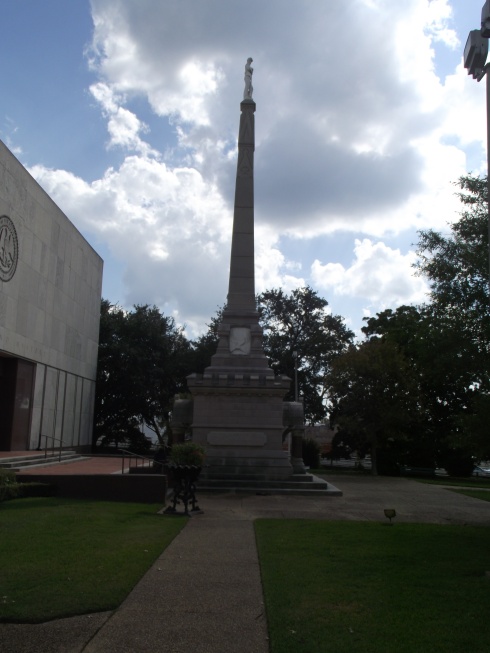The next “Artifact of the Month” to be displayed at the OCM is Governor John Marshall Stone’s top hat, which he wore during his inauguration. Governor Stone served as governor of Mississippi for two nonconsecutive terms, 1876-1882 and 1890-1896, making him one of the last governors to hold the position at the Old Capitol before the government was moved into the current Capitol. His top hat is a combination of fabrics and is an excellent example of nineteenth century fashion for men. Stone was governor immediately following Congressional Reconstruction and presided over a period when the state strove to find its identity in the re-emergence of the newly united nation. This hat is just one of the numerous objects that the Mississippi Department of Archives and History has in its collection.
Creating a Historical Landscape
11 OctThe Old Capitol Museum is situated in effectively what can be called ‘History Row,’ with the Winter Archives Building just across Amite Street and the Capers Building, which houses much of MDAH’s collection, next door to the Old Capitol Museum. However, these are not the only historical aspects of this area. Two notable items are the memorials on either side of the OCM, the Mississippi War Memorial on one side and the Monument to the Confederate Dead on the other. What is the significance of the location of these memorials? What do they tell the public?
The Mississippi War Memorial is a memorial to those Mississippians who served in wars including the French and Indian War, the Civil War and World War I. The memorial, itself, features sculptures of soldiers from World War I prepared for battle. In the courtyard of the memorial, which also doubles as a functioning office building, is a tomb-like structure which commemorates all those from Mississippi who fought in these wars. This is the type of memorial one would expect to see on the national scale and is very reminiscent of the National Mall. The Monument to the Confederate Dead is not quite expected to be seen at the National Mall anytime soon. At the base of the monument is a large tomb-like structure that encloses a statue of Jefferson Davis, which was formerly housed in the Old Capitol Museum. At the top of the monument is a statue of a generic Confederate soldier. This monument is considered controversial because it keeps alive a piece of Mississippi history that was incredibly discriminatory and has now evolved into a difficult subject.
What is the significance of these memorials in relation to the Old Capitol Museum? Like the example of the National Mall, these memorials did not always exist. The existence of these memorials was part of the conscious choices made by a group to depict a particular moment in history. Both of these memorials highlight the themes of sacrifice and honor by Mississippi citizens. They do, however, create a contradiction. One represents a sense of national unity and pride, while the other celebrates the Confederate cause during the Civil War. The placement of these two memorials on either side of the Old Capitol Museum is perhaps to establish a sense of historical legitimacy. The Old Capitol is one of the most identifiable and historic buildings in the state. These two very different, yet permanent, memorials show the complex nature of Mississippi’s identity despite the time that has since passed. Memorials are important because they represent a sense of permanency, a permanency that exists through the conscious decision to display such themes through these monuments; themes that highlight the complexity of how Mississippi is identified. Thus, a ‘History Row’ is created through these memorial placements surrounding the Old Capitol Museum.
LT




